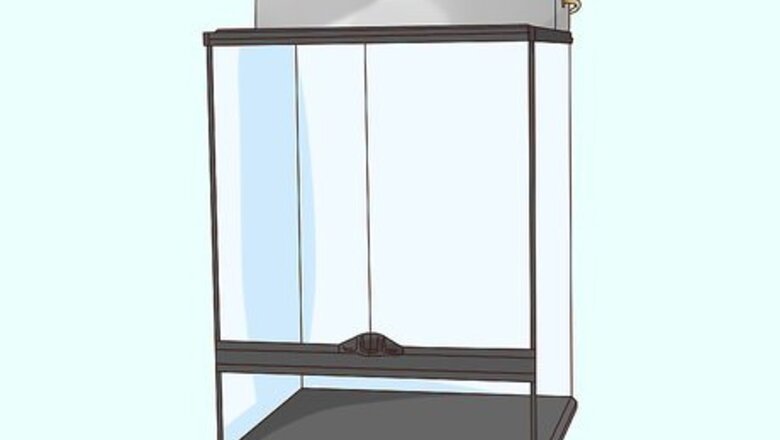
views
Setting Up the Habitat

Set up a large terrarium. Crested geckos are arboreal, meaning they live in trees, so make sure to get a vertical terrarium. Cresties will love having some space. If you're starting out with a baby gecko, look for a 10-gallon vertical glass terrarium at a pet store. If you have an adult gecko (or once your baby grows up), get a 20 gallon one. You could also get a 20 gallon (75.7 L) tank and flip it vertically because crested geckos naturally climb trees, and don't crawl on the ground. If using an Exo Terra, they need a tank that's 18x18x24 in inches minimum for a juvenile gecko and 45x45x60 cm for an adult. Crested geckos need a lot of humidity. You need to mist down the entire tank at night and a small mist in the morning, in order for the water to naturally collect, so that the crested geckos can drink. you may also put a bowl of water. If it's normally very humid where you live, you can also try housing your crested gecko in a cage with screen sides. Be sure to use a digital hygrometer.
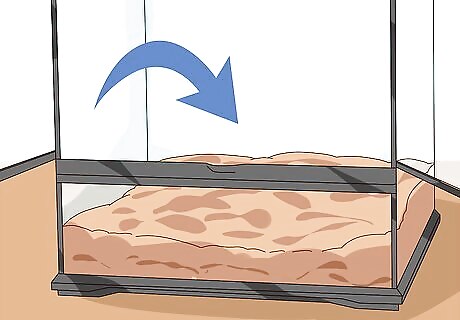
Add a layer of substrate to your crestie's home. Pet stores will stock soil meant to be used in reptile houses. A mixture of peat moss or coco fiber and soil will also work just fine but when first get your pet damp paper towel will do. Whichever substrate you use, place enough in your terrarium to cover the bottom well.
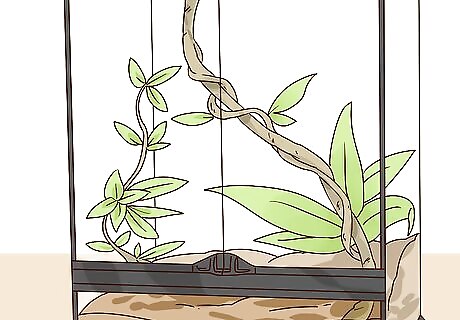
Place live or fake plants in the terrarium. Keep in mind that live plants need the correct type of soil and lighting. Your gecko will appreciate having lots of plants to climb on and hide under. Plants will also help regulate the humidity in the terrarium, making it more comfortable for the gecko . Your local pet store should stock some plants that will work great in your terrarium and will be safe for your gecko. Make sure that the plants that you buy are waterproof. Pothos and bromeliad are good options. Remember that Cresties in the wild live in bushes, trees, and things they can climb on. You can buy suction cupped plants that you can attach to the sides of your tank and on the back. Cresties only go to the ground to shed, so it doesn't matter if their habitat isn't wide.
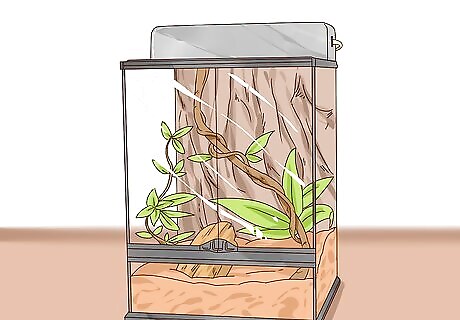
Give your crestie some things to play on. Since your crested gecko will spend most of its time inside the terrarium, try to make it an interesting habitat. Place things like pieces of driftwood or bark in the terrarium. Your crestie will love climbing on and crawling under them.
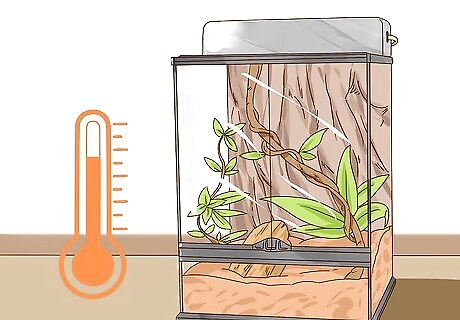
Keep the terrarium warm. Cresties come from warm habitats, so they'll do best in a terrarium that's a little toasty, but make sure that it does not get too hot. The average temperature in the terrarium should hover a little below 78 °F (26 °C). It's fine if the temperature dips a below this at night, but the daytime temperature should not go below 65 °F (18 °C). If the temperature in your area is higher than cresties tolerate, make sure to put the terrarium in a cooler room. The temperature in the terrarium should never go above 78 °F (26 °C) or your gecko may become stressed. If you need to warm to terrarium to keep it comfortable for your crestie, look for a ceramic heat emitter at a pet store. Connect it to a thermostat. Place the heater over just one side of the terrarium, so that the gecko can move to a cooler side when it needs to regulate its temperature, like reptiles naturally do. Be sure to use a digital thermometer.
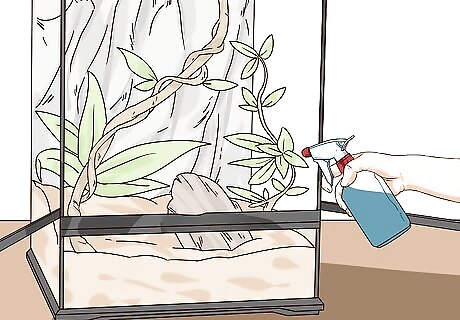
Keep the terrarium humid. Crested geckos will thrive when the humidity is maintained at between 50 and 70 percent. To keep it humid, you can mist the terrarium once or twice per day with a spray bottle of water, or place a cool mist humidifier nearby. If you want to keep track of the exact humidity inside the terrarium, go to your pet store and buy a hygrometer that can be attached to its side.
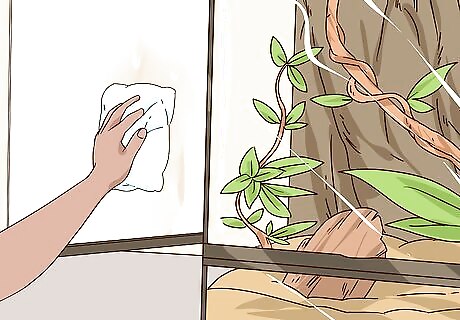
Clean your crestie's cage regularly. Spot clean the terrarium every day by wiping up any grimy spots with a paper towel. Deep clean the terrarium once a week. Wipe down the sides, clean your gecko's water dish thoroughly, and remove any debris from the plants or lay items. A cloth and water should take care of most messes inside the terrarium. If you have to use any soap, make sure to rinse it off thoroughly.
Feeding Your Gecko
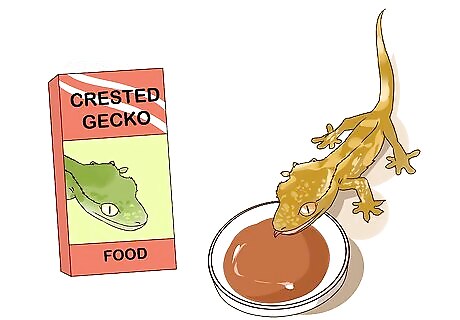
Feed your gecko a balanced diet. Pet stores will carry a powder mix that contains all of the nutrients that crested geckos need. Mix this with two parts water and put it in a dish inside the terrarium. Provide your gecko as much as it wants to eat three times a week.
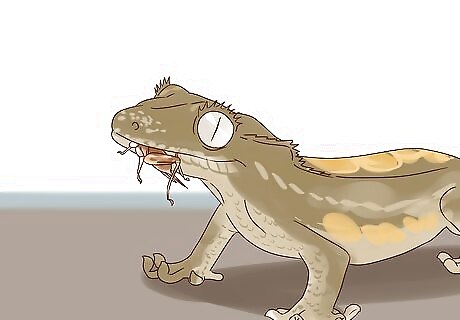
Give your crestie some treats. While the powdered food will keep your crestie nourished, it will love a few treats as well. You can give it bits of fruit (apricots or peaches are good choices). Dusted gut loaded crickets are another snack your crestie will love and can be found at a pet store. You can also dust the crickets with calcium powder yourself before feeding them to your gecko. Give your gecko crickets or fruit three times a week if you want to supplement its regular diet, or once a week if you just want to give it a treat. Crickets should be more of a treat to your Cresties. In the wild, Cresties will eat crickets but they eat fruit too. You should give them food specifically for Crested Geckos at your local pet store. Be aware that some Cresties will NOT go to the bottom just for food. It's best if you get them a Repti-Ledge. A Repti-Ledge is a food dish that has suction cups on the back. Attach it higher up so you're Crestie doesn't have to go to the bottom just for food. Most Cresties prefer this.
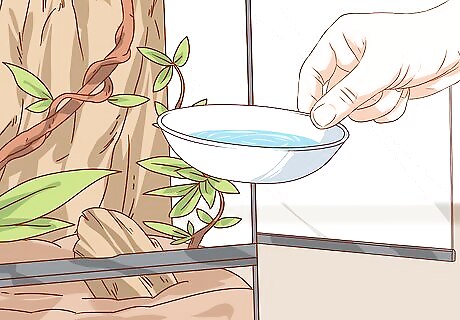
Provide your gecko with plentiful water. A shallow dish of water should be placed in the bottom of your crested gecko's terrarium. Keep it constantly full. Don't be concerned if your crestie also uses this dish as a potty, but make sure to clean his dish daily.
Handling Your Crestie
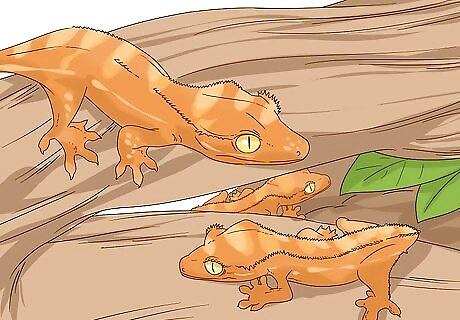
Group your geckos if you have more than one (Not recommended). Crested geckos will live just fine all by themselves. However, you can house a single male together with several females, or pair a couple of females together. Just avoiding pairing two males in the same terrarium, since they can become aggressive with each other. Keep in mind that your geckos may fight even if they are not both males. Watch for signs of tail nipping, biting, or other injuries in your geckos. Separate your geckos if you notice any of these things. Make sure to ask about the sex of your geckos when you purchase them.
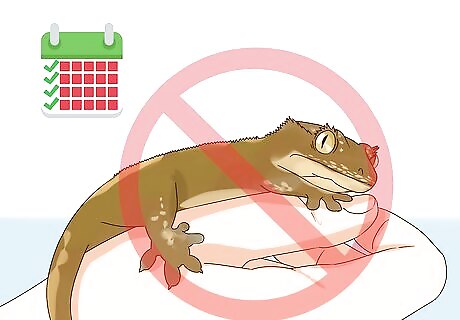
Avoid handling your gecko at first. It takes cresties some time to get used to a new environment. After you bring yours home, don't handle it for the first three to four weeks. This will give it time to become acclimated to the new setting without becoming stressed. After a few weeks, handle your crestie for only five minutes or so at a time, at first. Do this until your gecko is at least three inches long.

Handle your gecko gently. Cresties are surprisingly fragile. Falls can really hurt them. When handling yours, keep it just above a flat surface, like a table. If you need to move your gecko over a distance, keep it in its terrarium.
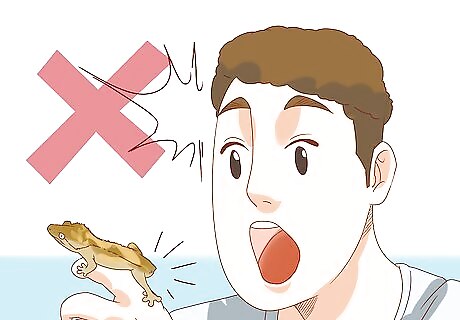
Don't be alarmed if your gecko loses its tail. People love the colorful patterns on the skin of geckos, including their tails. However, the tails are fragile. If you handle a crestie roughly, its tail may fall off, or this may happen all by itself. This won't harm your gecko, but the tail will not grow back.
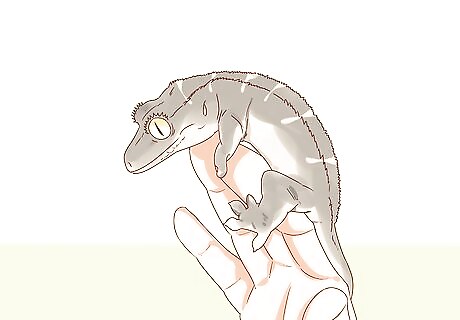
Note that crested geckos get stressed out easily. When your crestie is exposed to too much light, it may change color. If you hold the gecko and its color changes to an ash gray, put it back in the terrarium and let it return to its normal color.













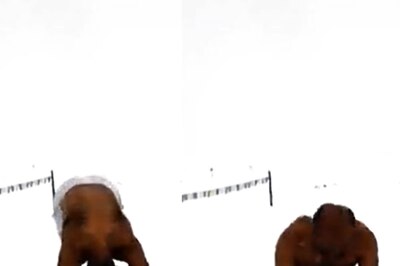





Comments
0 comment